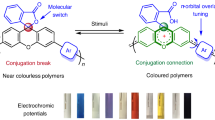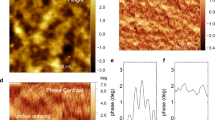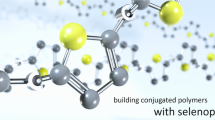Abstract
Controlling the molecular orientation of conjugated polymers is a vital yet complex process to modulate their optoelectronic properties along with boosting device performance. Here we propose a molecular-force-driven anisotropy strategy to modulate the molecular orientation of conjugated polymers. This strategy relies on the intermolecular interactions, gauged by the Hansen solubility parameters framework, to provide solvent selection criteria for conjugated polymers that render films with a preferential orientation. We showcase molecular-force-driven anisotropy to overcome the inverse coupling between the electrical conductivity and Seebeck coefficient in solution-processed organic thermoelectrics, a major challenge in the field. Our kinetic Monte Carlo simulations suggest that edge-on orientations break the trade-off by increasing the in-plane delocalization length. The molecular-force-driven anisotropy approach yields a power factor of 115 μW m−1 K−2 and a figure of merit of 0.17 at room temperature for the doped n-type 2DPP-2CNTVT:N-DMBI system. This power factor is 20 times larger than that of conventional doping approaches.
This is a preview of subscription content, access via your institution
Access options
Access Nature and 54 other Nature Portfolio journals
Get Nature+, our best-value online-access subscription
$32.99 / 30 days
cancel any time
Subscribe to this journal
Receive 12 print issues and online access
$259.00 per year
only $21.58 per issue
Buy this article
- Purchase on SpringerLink
- Instant access to full article PDF
Prices may be subject to local taxes which are calculated during checkout





Similar content being viewed by others
Data availability
The main data supporting the findings of this study are available within the Article and its Supplementary Information. Alternative formats for raw data files may be requested from the corresponding authors. 2D GIWAXS diffractograms of P3HT, N2200 and 2DPP-2CNTVT are available via the KAUST repository at https://doi.org/10.25781/KAUST-1709U (ref. 55). Source data are provided with this paper.
Code availability
Code for the KMC and three-phase model is available from M.K. upon request.
References
Marina, S. et al. Semi-paracrystallinity in semi-conducting polymers. Mater. Horiz. 9, 1196–1206 (2022).
Cowen, L. M., Atoyo, J., Carnie, M. J., Baran, D. & Schroeder, B. C. Review—organic materials for thermoelectric energy generation. ECS J. Solid State Sci. Technol. 6, N3080–N3088 (2017).
Tietze, M. L. et al. Elementary steps in electrical doping of organic semiconductors. Nat. Commun. 9, 1182 (2018).
Bubnova, O. & Crispin, X. Towards polymer-based organic thermoelectric generators. Energy Environ. Sci. 5, 9345–9362 (2012).
Bubnova, O. et al. Optimization of the thermoelectric figure of merit in the conducting polymer poly(3,4-ethylenedioxythiophene). Nat. Mater. 10, 429–433 (2011).
Villalva, D. R., Haque, M. A., Nugraha, M. I. & Baran, D. Enhanced thermoelectric performance and lifetime in acid-doped PEDOT:PSS films via work function modification. ACS Appl. Energy Mater. 3, 9126–9132 (2020).
Patel, S. N. et al. Morphology controls the thermoelectric power factor of a doped semiconducting polymer. Sci. Adv. 3, e1700434 (2017).
Liu, Z. et al. Enhancement of the thermoelectric performance of DPP based polymers by introducing one 3,4-ethylenedioxythiophene electron-rich building block. J. Mater. Chem. C 8, 10859–10867 (2020).
Schlitz, R. A. et al. Solubility-limited extrinsic n-type doping of a high electron mobility polymer for thermoelectric applications. Adv. Mater. 26, 2825–2830 (2014).
Liu, J. et al. Amphipathic side chain of a conjugated polymer optimizes dopant location toward efficient n-type organic thermoelectrics. Adv. Mater. 33, e2006694 (2021).
Rosas Villalva, D. et al. Backbone-driven host-dopant miscibility modulates molecular doping in NDI conjugated polymers. Mater. Horiz. 9, 500–508 (2022).
Liu, J. et al. N-type organic thermoelectrics: demonstration of ZT > 0.3. Nat. Commun. 11, 5694 (2020).
Shi, K. et al. Toward high performance n-type thermoelectric materials by rational modification of BDPPV backbones. J. Am. Chem. Soc. 137, 6979–6982 (2015).
Yan, X. et al. Pyrazine-flanked diketopyrrolopyrrole (DPP): a new polymer building block for high-performance n-type organic thermoelectrics. J. Am. Chem. Soc. 141, 20215–20221 (2019).
Gamez-Valenzuela, S. et al. High-performance n-type organic thermoelectrics with exceptional conductivity by polymer-dopant matching. Angew. Chem. Int. Ed. 63, e202408537 (2024).
Brunetti, I., Dash, A., Scheunemann, D. & Kemerink, M. Is the field of organic thermoelectrics stuck? J. Mater. Res. 39, 1197–1206 (2024).
Liang, Z. et al. n-type charge transport in heavily p-doped polymers. Nat. Mater. 20, 518–524 (2021).
Xu, K. et al. On the origin of Seebeck coefficient inversion in highly doped conducting polymers. Adv. Funct. Mater. 32, e2112276 (2022).
Untilova, V. et al. High thermoelectric power factor of poly(3-hexylthiophene) through in-plane alignment and doping with a molybdenum dithiolene complex. Macromolecules 53, 6314–6321 (2020).
Upadhyaya, M., Boyle, C. J., Venkataraman, D. & Aksamija, Z. Effects of disorder on thermoelectric properties of semiconducting polymers. Sci. Rep. 9, 5820 (2019).
Hynynen, J. et al. Enhanced thermoelectric power factor of tensile drawn poly(3-hexylthiophene). ACS Macro Lett. 8, 70–76 (2019).
Qu, S. et al. Highly anisotropic P3HT films with enhanced thermoelectric performance via organic small molecule epitaxy. NPG Asia Mater. 8, e292 (2016).
Vijayakumar, V. et al. Bringing conducting polymers to high order: toward conductivities beyond 105 S cm−1 and thermoelectric power factors of 2 mW m−1 K−2. Adv. Energy Mater. 9, e1900266 (2019).
Vijayakumar, V. et al. Influence of dopant size and doping method on the structure and thermoelectric properties of PBTTT films doped with F6TCNNQ and F4TCNQ. J. Mater. Chem. C 8, 16470–16482 (2020).
Campoy-Quiles, M. Will organic thermoelectrics get hot? Philos. Trans. A Math. Phys. Eng. Sci. 377, 20180352 (2019).
Scheunemann, D. et al. Rubbing and drawing: generic ways to improve the thermoelectric power factor of organic semiconductors? Adv. Electron. Mater. 6, e2000218 (2020).
Derewjanko, D. et al. Delocalization enhances conductivity at high doping concentrations. Adv. Funct. Mater. 32, e 2112262 (2022).
Li, M. et al. Controlling the surface organization of conjugated donor-acceptor polymers by their aggregation in solution. Adv. Mater. 28, 9430–9438 (2016).
Luzio, A., Criante, L., D’Innocenzo, V. & Caironi, M. Control of charge transport in a semiconducting copolymer by solvent-induced long-range order. Sci. Rep. 3, 3425 (2013).
Wang, S. et al. Solvent effects and multiple aggregate states in high-mobility organic field-effect transistors based on poly(bithiophene-alt-thienothiophene). Appl. Phys. Lett. 93, 162103 (2008).
Fratini, S., Nikolka, M., Salleo, A., Schweicher, G. & Sirringhaus, H. Charge transport in high-mobility conjugated polymers and molecular semiconductors. Nat. Mater. 19, 491–502 (2020).
Shi, X. et al. Relating chain conformation to the density of states and charge transport in conjugated polymers: the role of the β-phase in poly(9,9-dioctylfluorene). Phys. Rev. X. 9, 021038 (2019).
Jacobs, I. E. et al. Structural and dynamic disorder, not ionic trapping, controls charge transport in highly doped conducting polymers. J. Am. Chem. Soc. 144, 3005–3019 (2022).
Giannini, S. et al. Transiently delocalized states enhance hole mobility in organic molecular semiconductors. Nat. Mater. 22, 1361–1369 (2023).
Dash, A. et al. Spontaneous modulation doping in semi-crystalline conjugated polymers leads to high conductivity at low doping concentration. Adv. Mater. 36, e2311303 (2023).
Corzo, D. et al. High-performing organic electronics using terpene green solvents from renewable feedstocks. Nat. Energy 8, 62–73 (2022).
Chang, J.-F. et al. Enhanced mobility of poly(3-hexylthiophene) transistors by spin-coating from high-boiling-point solvents. Chem. Mater. 16, 4772–4776 (2004).
Kim, H. S., Huseynova, G., Noh, Y.-Y. & Hwang, D.-H. Modulation of majority charge carrier from hole to electron by incorporation of cyano groups in diketopyrrolopyrrole-based polymers. Macromol 50, 7550–7558 (2017).
Yang, C. Y. et al. Enhancing the n-type conductivity and thermoelectric performance of donor-acceptor copolymers through donor engineering. Adv. Mater. 30, e1802850 (2018).
Xiong, M. et al. Efficient n-doping of polymeric semiconductors through controlling the dynamics of solution-state polymer aggregates. Angew. Chem. Int. Ed. 60, 8189–8197 (2021).
Yan, X. et al. Approaching disorder-tolerant semiconducting polymers. Nat. Commun. 12, 5723 (2021).
Han, J. et al. Blended conjugated host and unconjugated dopant polymers towards n-type all-polymer conductors and high-ZT thermoelectrics. Angew. Chem. Int. Ed. 62, e202219313 (2023).
Wolf, C. M. et al. Strategies for the development of conjugated polymer molecular dynamics force fields validated with neutron and X-ray scattering. ACS Polym. Au 1, 134–152 (2021).
Cao, Z. et al. Molecular structure and conformational design of donor-acceptor conjugated polymers to enable predictable optoelectronic property. Adv. Mater. 35, e2302178 (2023).
Liu, J. et al. N-type organic thermoelectrics of donor-acceptor copolymers: improved power factor by molecular tailoring of the density of states. Adv. Mater. 30, e1804290 (2018).
Wang, S. et al. A chemically doped naphthalenediimide-bithiazole polymer for n-type organic thermoelectrics. Adv. Mater. 30, e1801898 (2018).
Ma, W. et al. Enhanced molecular packing of a conjugated polymer with high organic thermoelectric power factor. ACS Appl. Mater. Interfaces 8, 24737–24743 (2016).
Yang, C. Y. et al. A thermally activated and highly miscible dopant for n-type organic thermoelectrics. Nat. Commun. 11, 3292 (2020).
Craighero, M. et al. Impact of oligoether side-chain length on the thermoelectric properties of a polar polythiophene. ACS Appl. Electron. Mater. 6, 2909–2916 (2023).
Guo, H. et al. Transition metal-catalysed molecular n-doping of organic semiconductors. Nature 599, 67–73 (2021).
Lu, Y. et al. The critical role of dopant cations in electrical conductivity and thermoelectric performance of n-doped polymers. J. Am. Chem. Soc. 142, 15340–15348 (2020).
Nečas, D. & Klapetek, P. Gwyddion: an open-source software for SPM data analysis. Cent. Eur. J. Phys. 10, 181–188 (2012).
Sharma, A. et al. Insights into the oxidant/polymer interfacial growth of vapor phase polymerized PEDOT thin films. Adv. Mater. Interfaces 5, 1800594 (2018).
Yoshida, H. Near-ultraviolet inverse photoemission spectroscopy using ultra-low energy electrons. Chem. Phys. Lett. 539–540, 180–185 (2012).
Rosas Villalva, D. & Baran, D. GIWAXS of conjugated polymers, 2DPP-2CNTVT, P3HT, and N2000. KAUST Research Repository https://doi.org/10.25781/KAUST-1709U (2024).
Acknowledgements
D.R.V. and D.B. thank the King Abdullah University of Science and Technology (KAUST) Office of Research Administration (ORA), award no. ORA-CRG2022-4668. We also would like to thank C. Muller for fruitful discussions on the influence of ionized species on the assembly of the morphology of doped CPs. M.K. thanks the Carl Zeiss Foundation for financial support. D.B., G.C. and S.M. acknowledge support from the UK–Saudi Challenge Fund grant from the British Council’s Going Global Partnerships programme.
Author information
Authors and Affiliations
Contributions
D.R.V. and D.B. supervised the work. D.R.V. conceived the idea and wrote the manuscript, as well as performed the AFM and GIWAXS characterizations. D.D. and M.K. performed and supervised the computational modelling. D.R.V., Y.L. and Y.Z. fabricated the devices and measured the electronic properties. D.R.V., Y.Z. and S.J. determined the HSPs. A.B. and X.G. carried out the AFM-IR characterization and analysis. A.S. performed the ultraviolet photoelectron spectroscopy and low-energy inverse photoemission spectroscopy measurements. J.H. performed the density functional theory calculations. O.Z.A. and Y.Z. performed the thermal conductivity measurements and analysis. M.G.-R. provided technical assistance with setup designs for characterization. S.M. and G.C. performed the STM measurements. All authors contributed to manuscript editing and revision.
Corresponding authors
Ethics declarations
Competing interests
The authors declare no competing interests.
Peer review
Peer review information
Nature Materials thanks the anonymous reviewers for their contribution to the peer review of this work.
Additional information
Publisher’s note Springer Nature remains neutral with regard to jurisdictional claims in published maps and institutional affiliations.
Extended data
Extended Data Fig. 1 N-DMBI’s Ra vs solvents and polymer.
The Ra between N-DMBI and 2DPP-2CNTVT is equal to that of N-DMBI and o-DCB this means that N-DMBI is equally likely to interact with either of them. N-DMBI’s Ra to CB is larger than that of 2DPP-2CNTVT meaning that the dopant will more likely interact with the CP.
Extended Data Fig. 2 CP solution aggregation behaviour upon addition of dopant.
a) In a perfect solvent, polymer chains are fully dissociated. b) In an intermediate solvent, polymer chains are both fully dissociated and forming small lamellar aggregates. c) Partial solvents give result to large polymer aggregates. Addition of dopant in a perfect solvent result in good CP-dopant intercalation owing to full dissociation of polymer aggregates, without a significant change in the aggregation behaviour. This is similar to adding a dopant in an intermediate solvent, where the CP has lower or affinity for the dopant than for the solvent (d). This should produce minimal effect on the resulting thin film morphology. In contrast, adding a dopant to an intermediate solvent (e) where the CP has similar or higher affinity for the dopant than for the solvent, a competing interaction is triggered that increases the polymer aggregates in solution. This case should result in an increase in the crystalline fraction and the EFR. Finally, in (f), adding dopants in a bad solvent should result in a decrease in the aggregates, due to the dopant attempting to intercalate with the CP. This should produce a film with hindered crystallinity and lower EFR.
Supplementary information
Supplementary Information
Supplementary Note 1, Figs. 1–29 and Tables 1–5.
Supplementary Data 1
2DPP-2CNTVT density-functional-theory-optimized atomic coordinates.
Source data
Source Data Fig. 2
TE properties calculated using KMC, plotted in Fig.2c–e. Charge paths in the anisotropically and isotropically generated morphologies plotted in Fig. 2f,g.
Source Data Fig. 3
SS function and solvent coordinates shown in Fig. 3c, EFR dependence on Ra and BP plotted in Fig. 3d,f and change in EFR versus Ra plotted in Fig. 3g.
Source Data Fig. 4
d spacing, relative crystallinity and EFR from the GIWAXS data plotted in Fig. 4d–g.
Source Data Fig. 5
OFET transfer curves shown in Fig. 5a,b. Thermal conductivity plotted in Fig. 5c. Seebeck coefficient versus conductivity plotted in Fig. 5d. PF versus EFR plotted in Fig. 5e. Previously reported TE properties plotted in Fig. 5f. Temperature-dependent PF and ZT plotted in Fig. 5g.
Rights and permissions
Springer Nature or its licensor (e.g. a society or other partner) holds exclusive rights to this article under a publishing agreement with the author(s) or other rightsholder(s); author self-archiving of the accepted manuscript version of this article is solely governed by the terms of such publishing agreement and applicable law.
About this article
Cite this article
Rosas Villalva, D., Derewjanko, D., Zhang, Y. et al. Intermolecular-force-driven anisotropy breaks the thermoelectric trade-off in n-type conjugated polymers. Nat. Mater. 24, 1236–1244 (2025). https://doi.org/10.1038/s41563-025-02207-9
Received:
Accepted:
Published:
Issue date:
DOI: https://doi.org/10.1038/s41563-025-02207-9
This article is cited by
-
Tilting the way to organic thermoelectrics
Nature Materials (2025)



